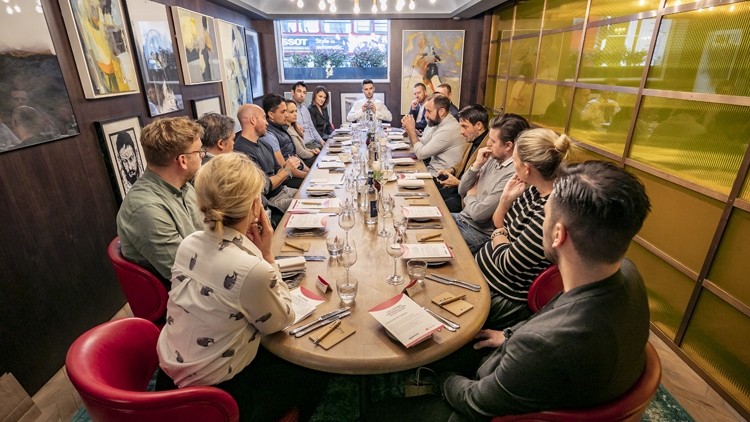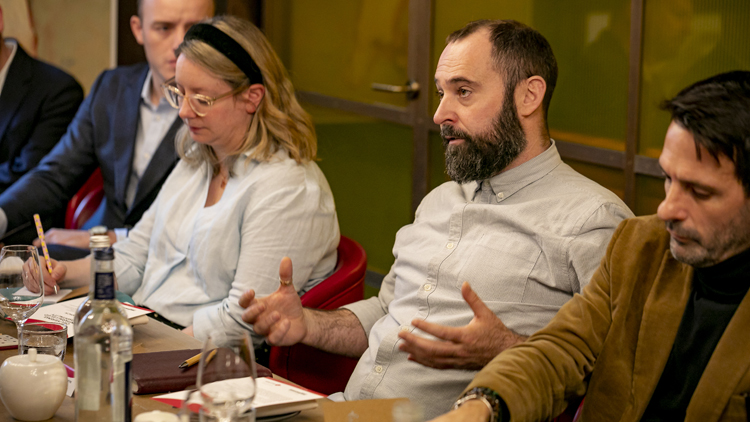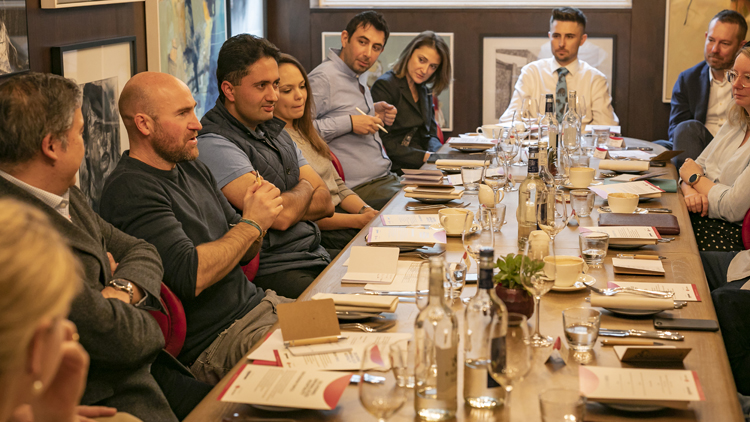In association with OpenTable
How can restaurants provide a more personal service?

Everyone likes to have personal service when they visit a restaurant, and every business wants to be able to deliver that. Yet, a restaurant’s ability to do this is based on a number of factors, including how they take reservations and collect customer data to how they use that data to improve the dining experience and encourage repeat custom. So we decided to ask operators themselves the techniques they use to provide that more personal touch. Here’s what they said.
Creating a stellar customer experience
Gordy McIntyre (co-owner, Hicce): When we opened Hicce we used social media to build up our personality. To do that we first had to instil that in our staff, because at the end of the day your staff are your main tool – if they buy into what you’re doing and your beliefs and dreams, they can get that across to customers. It’s hard to stand out – we serve food and drink like everyone else so why should people come back to us? It’s because our guys have personality and live and breathe what we’re about.
Paulo de Tarso (co-owner, Margot): I build my reputation on working the floor. A lot of people don’t understand the difference between hospitality and service we’re in a business about how we make people feel. For me, it’s about values. You can train anyone to serve a table correctly but what I focus on is empathy. The biggest compliment I can get from a customer is ‘Margot is my favourite restaurant’.
Tom Foxwell (group GM, Hawksmoor): Staff need to be able to read the table and know who are the people who want all the bells and whistles and who just want to be left alone.
The personal approach
Adrian Valeriano (VP global sales and services EMEA, OpenTable): Everybody approaches things differently. We use words like personalisation and loyalty and from a diner perspective really what that means is recognition – are they being recognised? Some 75% of diners say they are more likely to return to a restaurant that remembers their name and that can recommend dishes based on a previous visit (source: Accenture Interactive Personalization Research).
GM: It’s an ongoing exercise and it’s not easy to get across, you need be very particular about the people you employ. We need to make it personal from the first time they walk through the door.
Nick Jarman (general manager, OXO Tower restaurants): The challenge for personalisation is to make it personal for your new customers. For the regular ones it is quite easy because we know who they are, but to get the personal touch for the new customer and to try to understand why they are here and what their needs are is harder.
AV: When we think about the new business we send to restaurants, our ability to ask diners ‘what are you comfortable sharing with a restaurant?’ is one way we are able to help restaurants get information from new diners and start that first interaction off right. Rather than trying to do that all yourself, it’s a great way of using a partnership to accomplish something more personalised. Knowing more about a first-time guest is important.
PDT: Anticipation is key. Lunchtime regulars want a different experience than when they are having dinner with their families. Our lunchtime service is quicker, people want to eat and go, so the way we seat tables and take an order is very precise.
Sarah Guignard (co-owner, The French Table): That personal service must always come from you – and that comes down to the first contact the customer has with your restaurant. The majority of our customers still make a phone reservation rather than by email so it’s really important we get their name right and understand whether they are celebrating something. Those first notes made are gold dust. Even if it was just one line, that still would be communicated in the briefing at the beginning of service which would help to provide a more personalised experience.
Fateh Dhaliwal (director, Tamarind Restaurant Group): If you’re starting a Friday service with 300 bookings, going through all the notes will take 45 minutes, people just get bored. There’s not enough time to discuss every table. We used to find it simple when the restaurant was small but as it’s grown it has become really challenging.
PDT: I disagree. Briefing is how you set the mood, it’s everything. But it’s got to be quick – everybody must get to the point.
Brigita Diukovaite (communications and marketing manager, Frenchie): Briefings are so important. If you have 500 customers not every one needs a note, but you should identify the information that is most important.
AV: Nobody wants a dump of information that your staff have to spend hours reading through. You need to highlight those five or six things that will really make a difference to the day’s service and focus on them.
Collecting customer data
FD: You need your reservations and EPoS systems to talk to each other. We do 270 covers on a Friday and Saturday night, nobody has the time to go and feed in all that data and it would be stupid to ask managers to do that. It won’t happen and if it does the quality of the data won’t be good.
Michele Vollaro (general manager, Cafe Murano): Reservation data is essential. You’ve got to collect the right information, so that part of staff training is vital. You need the right email address and to understand who’s doing the booking – is it the person dining or is it their PA? We encourage staff to read the name on the credit card when they take the payment and to try to get some customer information and an email address, so the next time they visit there is something to go on. You are never going to build a database in three days, it will take years. But once you have created a strong database it’s great. We can now tell regular customers that we have opened a restaurant closer to where they work.
FD: One of the things we learnt was our restaurant in Soho is next to the Candy Crush office, but the Candy Crush client was going to Mayfair twice a month with large bookings, they had no idea the restaurant opposite office was also ours. We communicated to them that we had a restaurant on their doorstep and it worked wonders. This all happened because we are collecting and looking at the data.
JL: I’d like to be able to build a customer database of how customer orders have changed so that we can anticipate their needs. Knowing that some people used to eat heavy food but now eat a lot lighter means we can make them feel more comfortable when they come in.
FD: Tamarind has three restaurants, in Mayfair, Soho and Kensington, and I run the business from the office. When we reopened the Mayfair restaurant there was a completely new team – all 80 staff were brand new. The only issue was our ex-general manager didn’t believe in computers. He was old school, always on the floor five days a week and knew every single guest. So we had a new restaurant but an existing clientele and the new management had no idea who they were. We’ve learnt the hard way that customer data is the most valuable asset you have.
BD: I saw the GDPR law change as a good opportunity to completely clear up our customer database. We sent out a personalised email asking people if they wanted to hear from us and in the past six months I have added 8,000 new customers to the database.
Julien Davain (general manager, Wild Honey): When we decided to close Wild Honey and move it [to The Sofitel St James’s] we contacted all our customers on our database with a newsletter to let them know.
JL: The more that can be done to nurture and grow your customer database the better. Using data to deliver excellence
JL: We’ve been hammering the personalisation system ever since we’ve had OpenTable but it needs to be more fragmented. The amount you can write about a customer is down to you, we have regulars with 20 lines of information on them. But what I really want is to discover that five years ago a diner ordered this type of wine and now only orders this one, or that they’ve gone off drinking burgundy.
LB: It’s got to be relevant to the diner. If a restaurant told me I didn’t drink burgundy five years ago I probably wouldn’t remember, or care.
PDT: You get all this information but it’s what you do with it. You can have a Porsche but not know how to drive it, but it can do 200mph in the right hands. I’ve been to restaurants where they tell me what I ate last time I came and that can be creepy.
JL: But if you know that information and how to use it cleverly, it’s very helpful. The most wonderful thing in the world is when you arrive somewhere with a friend and the waiter knows a few things about you and your friend thinks ‘wow, this really is his place’. It boils down to how the person doing the service uses that data, but having it in the first place is crucial.
AV: It comes down to training.
TF: Yes, it’s got to be training. I don’t want to tell people what they had five years ago, it’s about balance. It has got to be a one-on-one experience, but you can’t be a stalker. If you are in a restaurant in Manchester and normally eat 200 miles away, it’s a bit weird if people know you. It comes down to the people who could maybe bring this up in a conversation later in the meal. Knowing who your guests are
TF: People have to be nosy – it helps if your staff are naturally curious.
AV: One of the things restaurants love to know is where their diners are from – what number of diners are local versus regional and international. For some restaurants that’s vital for how can they can take that information and find a way to make a personal connection when that guest walks in.
FD: We reached out to American Express to figure out where our cardholders were from – over 40% at our Mayfair restaurant were US residents, which was incredible. We employed two new sommeliers, one from Canada and one from the US, who are able to connect with the American customer in an instant. If a manager said we had a lot of American guests in you don’t act on that, we needed to know how many covers we were doing with US cardholders.
AV: One of the big things we’ve pushed out on GuestCenter due to restaurant feedback is who are a restaurant’s top 50 guests and their number of visits. If you are looking at this top 50 and see very few notes on your customers there’s an issue – how do you engage your team to be proactive about populating this data? OpenTable Venga allows restaurants to bring together EPoS data and financial data to identify patterns and trends – that’s the next chapter we are building with restaurants. It’s key to have a great partner that does the tedious lifting and helps you solve problems but still leaves you in the driving seat to create those magic moments with your guests.
Feedback and reviews
GM: I answer all the reviews personally. It helps if people look at your reviews and they see your response, it creates a persona for the restaurant. We’ve had customers come in and ask if I’m the guy behind the responses.
PDT: People are judging us at every corner, everybody wants to be a critic. But it’s very beneficial – you can tell when they are being honest, or whether they just want something for free. If they are being honest we invite them back in. Then you will build yourself a loyal clientele.
AV: The biggest single thing that makes a difference is whether reviews are verified or not. There are some review sites where you can put anything up, but the OpenTable ecosystem ensures that any restaurant reviews are verified. With OpenTable Review Manager a restaurant can see all its reviews in one place and get a daily digest of the good things being said about it across all channels.
FD: The best thing about OpenTable reviews is that it’s real diners. The part that confuses me is when people have the chance to review anonymously because you are not able to track that reservation. To take feedback on properly I need to know who the guest was and what happened during their visit.
JL: A recommendation one customer gives to another is the best way of driving new business we’ve found. We wanted to track that and encourage it so we introduced a system to ask the name of the recommender when a new customer comes in. When that person then next visits we thank them. That has gone crazy. The people who recommend us start doing it more and become unofficial ambassadors for the business because they know when they come they will be appreciated by us.
Targeted marketing
AV: Gone are the days of a mass email because the risk is too high, you get unsubscribers that will deplete you database. What is true is that personalisation drives ROI and a lift in sales, but it’s how a restaurant finds a way to personalise its communication. That’s where the data really matters – knowing where your customers come from and the kind of guest they are are two simple things that can help create a very personal way of talking to diners and inviting them back.
NJ: We use Google Analytics for the customers coming onto our website, then we can map some of the offers we do based on whether or not they are engaging with them. That’s a good way to see what they are looking at without them knowing. You’re then feeding that into the system based on their preferences.
FD: When we reopened Tamarind we were considering the power of email marketing. Rather than sending the client to our main restaurant website, we created a separate landing page for our newsletter to see how it performed. One newsletter led to 1,300 bookings.
JL: We looked into who were our top 600 spending guests in the past five years and we sent them special offers, letting them know they were getting them in advance. At the moment we can only see the amount of times they’ve booked, not the amount they have spent. If we could track how many times they have ordered the tasting menu rather than à la carte or ordered from the prestige wine list or the sommelier selection, that would be wonderful because we could offer tailored deals and not spam people.
This article was based on a roundtable discussion held in association with OpenTable.













